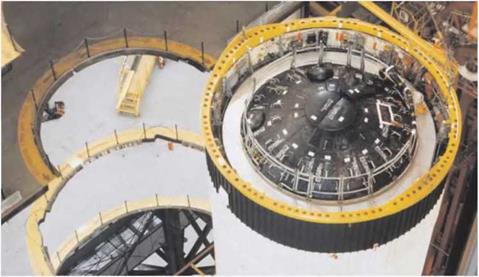Instrument unit: the mind of the machine
One of the fortuitous design choices made by the Apollo/Saturn engineers was that the rocket ought to depend, in the first instance, on its own guidance system rather than being controlled by the one in the spacecraft. All the equipment required to autonomously steer the vehicle was mounted on the inside of a 6.6- metre annular ring positioned atop the S-IVB that extended the height of the launch vehicle by one metre. This was the instrument unit, and examples were installed on both the Saturn IB and Saturn V. The unit included a digital computer, a stabilised guidance platform, sequencers and other kit to control the entire launch, the ascent to orbit and the burn to the Moon. However, arrangements were also made to allow the Apollo spacecraft to control the Saturn V in case of an instrument unit failure.
The Apollo 12 flight of November 1969 vindicated the engineers’ decision when
|
The instrument unit for Apollo 12 installed at the top of the launch vehicle stack prior to the addition of the Apollo spacecraft. (NASA) |
lightning hit the ascending vehicle shortly after launch. The guidance system in the command module was temporarily knocked out by the surge of current, yet the Saturn continued on its way under the control of its instrument unit, giving mission control and the crew time to recover from the disruption. Had the spacecraft’s systems been in control, the vehicle would have strayed off course and the mission would surely have been aborted by firing the LES motor.











